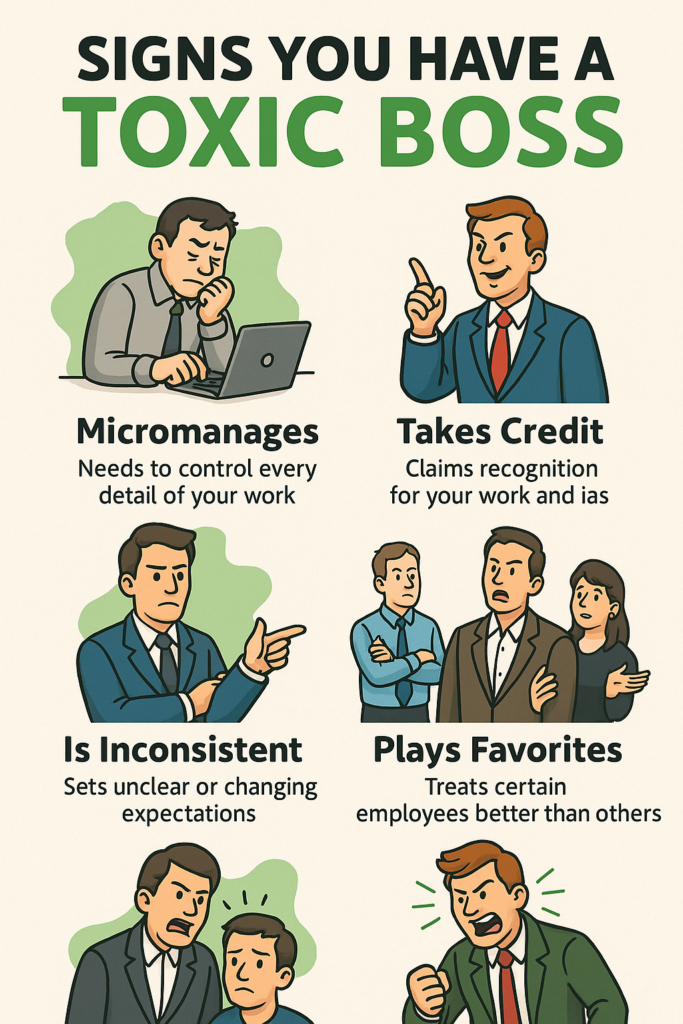A toxic boss can be one of the most challenging dynamics in any workplace. Whether it’s micromanagement, favoritism, poor communication, or blatant disrespect, dealing with such a leader can significantly affect both your mental well-being and your career trajectory. However, it’s possible to navigate this difficult situation with the right strategies.
-
Recognize the Signs of Toxic Behavior
Understanding what constitutes toxic leadership is the first step in managing your boss. Toxic behaviors include:
-
Micromanagement:
Constantly overseeing every detail of your work.
-
Manipulation and Gaslighting:
Making you question your perceptions or abilities.
-
Lack of Accountability:
Blaming others for their mistakes.
-
Disrespect and Favoritism:
Treating some employees better than others.
-
Unpredictability:
Erratic moods or expectations.

According to a Gallup survey, 75% of employees leave their jobs due to a bad relationship with their boss, highlighting the profound impact a toxic leader can have on employee morale and turnover.
-
Set Boundaries and Protect Your Mental Health
When dealing with a toxic boss, it’s crucial to maintain your emotional and mental well-being. Setting boundaries can help protect yourself from unnecessary stress:
-
Manage Expectations:
Be clear on what you can realistically accomplish, especially if your boss’s demands are excessive.
-
Take Breaks:
If your boss’s behavior is draining, ensure you’re taking time for self-care during the day.
-
Talk to HR (Discreetly):
If your boss’s behavior crosses into harassment or discrimination, consider seeking advice from HR on how to manage the situation while ensuring you’re protected.
Research shows that employees who don’t set boundaries experience higher stress levels and lower job satisfaction. Taking control of your mental space can, in turn, help you be more effective in handling the challenges presented by a toxic boss.
-
Communicate Effectively and Professionally
Communication can be a double-edged sword when dealing with a toxic boss. Here’s how to approach it:
-
Stay Calm and Focused:
Don’t let emotions dictate your responses. Practice clear, calm, and professional communication.
-
Document Important Conversations:
If your boss is unpredictable, document important meetings or discussions. This helps protect you in case your boss distorts your words or actions.
-
Use “I” Statements:
Frame your concerns around how you feel, rather than blaming the boss. For example, “I feel unclear about the direction of this project” rather than “You’re giving me mixed signals.”
One study published by the Journal of Applied Psychology found that employees who communicated assertively and stayed calm were less likely to feel the negative effects of toxic leadership.
-
Focus on Building Alliances and Support Networks
Working with a toxic boss can leave you feeling isolated. However, it’s crucial to build strong relationships with your peers and other leaders in the organization. Doing so can:
- Provide emotional support when you’re dealing with challenges.
- Help you gather different perspectives on how to handle the situation.
- Offer opportunities for growth outside the direct influence of your boss.
In fact, a Harvard Business Review article suggests that employees who build strong support networks within the company are better equipped to cope with toxic leadership and maintain high performance.
-
Know When to Seek New Opportunities
Sometimes, despite your best efforts, a toxic work environment can remain unmanageable. If the situation becomes untenable—affecting your health, performance, or career growth—it might be time to consider other options.

-
Assess Your Career Goals:
If the toxic behavior prevents you from reaching your professional goals, it’s okay to consider leaving.
-
Explore External Job Markets:
A toxic boss is often a sign of deeper organizational issues, so it’s worth exploring healthier environments.
A LinkedIn study shows that 54% of employees would leave their current role if they had a bad relationship with their manager, emphasizing that prioritizing mental health and professional development is crucial.
Conclusion
Managing a toxic boss is never easy, but by recognizing toxic behaviors, setting boundaries, communicating effectively, building support networks, and knowing when to leave, you can protect yourself and still thrive in your career. Remember, no job or boss is worth sacrificing your mental well-being and career growth.

